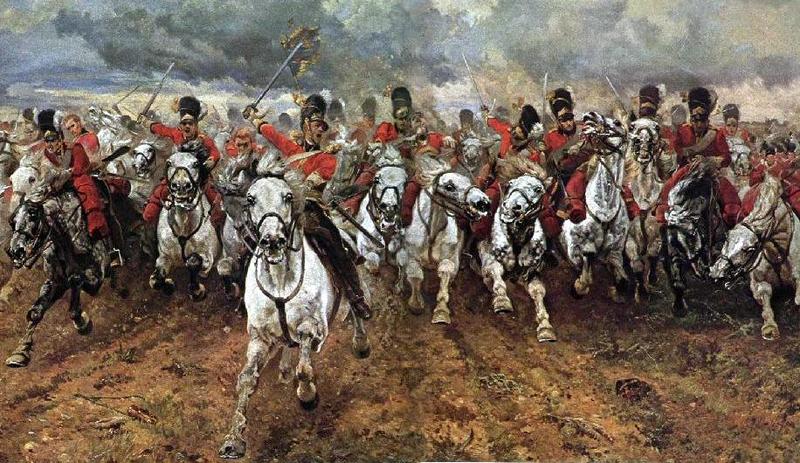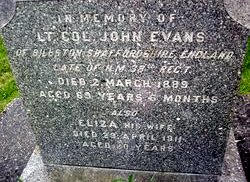
The distinguished gentleman in the photo above is John Evans, a Calais bookkeeper with, for his time, short hair and a neat, closely cropped beard. The date of the photo is uncertain, but we speculate it was taken in the 1870s. Evans is not a common local surname and John was not a native of the St. Croix Valley. He was born in Billstone, Staffordshire, England in 1820. He and his family did not settle in Calais until 1877, the only official record he ever lived in Calais is contained in the 1880 census.

He was then sixty and his family consisted of his English wife Eliza and two children, Helena eighteen and Arthur ten both born in New Brunswick. Other than two fairly short obituaries in the Calais Advertiser and the St. Croix Courier, there is not a single mention of John Evans in local historical documents.

Corner North and Main about the time John Evans arrived in Calais. Treat’s Bookstore on right, St. Croix Hotel second building on the left.

When John and his family arrived in Calais in 1877, Main Street was primarily the block shown above running east from North Street to Church Street. None of the brick blocks from North Street to the bridge had yet been built. John’s occupation is listed in the 1880 census as “Bookkeeper” and his employer may have been one of the local lumber barons or possibly O.P. Treat who had the bookstore at the corner of North and Main or perhaps even the Border City Hotel advertised in the photo above just visible in the distance and until recently the J.D Thomas gas station. We don’t have any idea where he kept the books because John Evans left no mark and made no impression it seems during his years as a resident of Calais. He was as stated in his 1889 obituary in the Calais Advertiser to be a man:
“who quietly resided in this city for some years. Very few who have seen his figure on the streets from time to time would have thought from his unassuming manner that he was a hero, that he had faced the cannon’s mouth in many a hard fought battle and that his bravery had been recognized by his superior officers and rewarded by his sovereign.”
Indeed, it is unlikely any resident of Calais, before or after, lived a more adventurous and perilous life than John Evans. When very young John enlisted in the 38th (Staffordshire) Regiment of Foot- in today’s parlance the infantry. The regiment was involved in nearly all the military engagements of the British Empire in its continuous struggle to preserve and expand the empire upon which, it is said, the sun never set. One of England’s most intense periods of sustained and violent confrontation with its foes and the native populations of its colonies was the 1850s and John Evans fought in all of these conflicts.

The most famous and to some extent most infamous conflict of that decade was the Crimean War, in which Christian England and France allied with Muslin Turkey to fight Christian Russia over Russia’s attempt to take Istanbul and the Black Sea lanes to the Mediterranean. Commerce trumped religion, the European powers feared Russia would gain control of the Eastern Mediterranean and a fierce and terrible war resulted, although it is remembered today largely for the Charge of the Light Brigade. The above painting shows that renowned English unit charging to senseless and inevitable slaughter into the teeth of massed Russian artillery. Although not a horseman, John Evans was engaged in the fighting, first at the battle of Alma River…

…and soon thereafter at the Battle of Inkerman, shown in the painting above.


He then joined the forces besieging the main Russian position at the port of Sevastopol where he very likely found himself under continuous shelling from guns of a young Russian artillery officer named Lev Tolstoy who is famous not only for writing what many consider the greatest novel ever penned, War and Peace, but also for his first hand and disturbing description of the horrors of the siege of Sevastopol in a book titled Sevastopol Sketches. Had John Evans been wounded in the battle he might have had his wounds treated by an idealistic young woman named Florence Nightingale. For his bravery in these battles Evans was awarded two medals by the Turkish government and the English Crimea medal with clasp for bravery. It may have been at this time that his superior officers took him from the ranks and commissioned him an officer. In a reminder that history really does often repeat itself we should point out that the same European forces are today again fighting the Russians over Crimea although now through proxies. The only change is the United States has replaced Turkey in opposition to the Russians.

Soon after the Crimean conflict ended, the Brits found themselves in trouble in India and not for the first or last time. Unsurprisingly they had only themselves to blame, the British being largely incompetent and culturally tone death imperialists.
In 1857 the British introduced the Enfield rifle to its troops in India, both regular army and native forces. To use the rifle’s cartridge, it had to be torn open with the teeth and the gunpower poured into the muzzle of the Enfield. The cartridges were sealed with grease from both pigs and cows thereby managing to offend both Muslim and Hindu native troops whose religion forbade putting either in their mouths. The native troops refused to use the Enfield, the Brits responded with threats, arrests and the disbanding of native units and the “Indian Rebellion” began with both sides committing monstrous atrocities against soldiers and defenseless women and children.
The British garrison in the city of Lucknow was besieged by rebel troops in what became one of the more celebrated actions of the rebellion. Had it fallen to the rebels the slaughter of British soldiers and civilians would have been dreadful. A first British relief column was turned back but a second, which included John Evans, managed to reach the city and evacuate the garrison and families.
After Lucknow, Evans was again decorated for his service and apparently promoted to the rank of Lieutenant Colonel, but it seems Evans had had enough of empire. In 1859 he sold his commission and moved to St. John New Brunswick. The “selling” of his commission may seem odd, officers in professional armies ordinarily “resign” their commissions but in the British army of that era many officers or as was more often the case their family purchased a young man’s commission. It was a way for aristocratic families to rid themselves of second and third sons who, if allowed to stay at home, could become a nuisance as they awaited the death of the elder brother and their ascension to the family treasure and title. Most were unqualified for any serious endeavor and in many cases were a menace to their own troops on the battlefield which explains the very sorry reputation of the British officer corps throughout history. Only British officers would have ordered the horsemen of the Light Brigade to charge distant mass artillery over an open plain. John Evans won his commission on the battlefield. He would be called a “mustang” in the U.S. Army, an enlisted man who came up through the ranks and was commissioned through valor and competence.

He died in Calais on March 22, 1889 and is buried in St. John with his wife Eliza. We thank Sharon Howland for both the photo of the gravestone and John’s photo. He had achieved the rank of Lt. Colonel and as noted sold his commission, probably the only asset he had in the world, and moved to St John in 1860 where he became the storekeeper for the regional militia. Why he moved to Calais in 1877 we cannot say but it was not at all unusual for New Brunswickers to settle in the States and vice versa. It seems clear he never “pulled rank” on Calais folks or spent his days hanging around O.P. Treat’s bookstore bragging about his exploits on the battlefield, which is a shame in a way because had he done so we might know a great deal more about Colonel John Evans.
